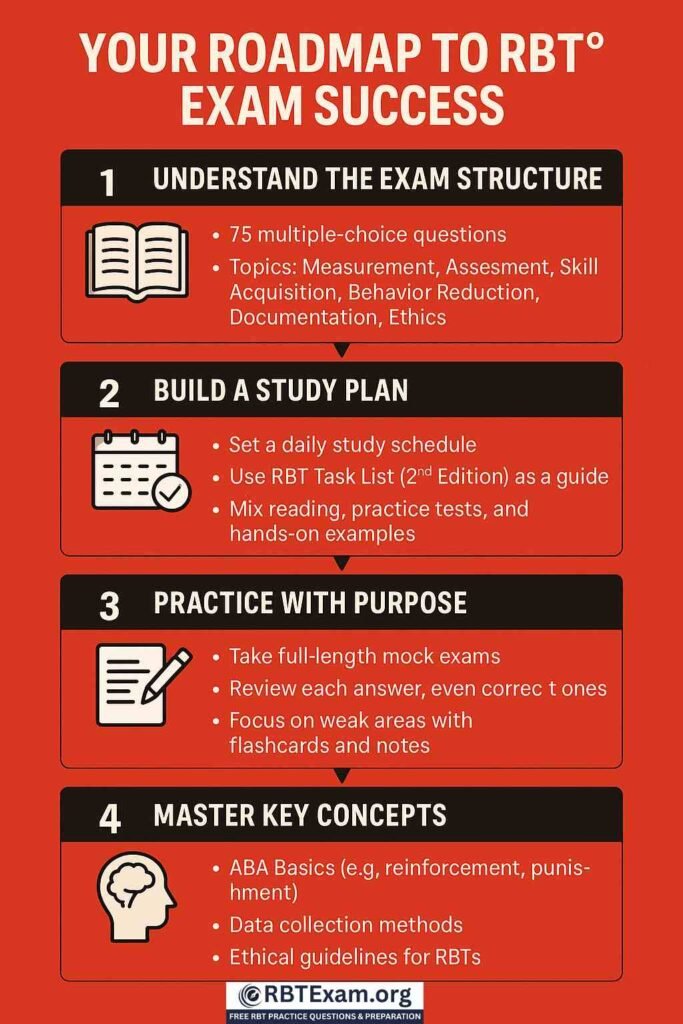Registered Behavior Technician (RBT®) Exam Structure Explained: Your Complete Guide
For those hoping to work in applied behavior analysis (ABA), the Registered Behavior Technician (RBT®) Exam is a key need. Under administration by the Behavior Analyst Certification Board (BACB), this computer-based test assesses a candidate’s capacity to apply basic AVA ideas in practical settings. Completing the 85 multiple-choice RBT test takes 90 minutes and consists of 75 scored and 10 unscored pre-test questions. Candidates have to get at least an 80% passing mark—that is, about 60 right answers out of 75 scored questions.
As specified in the RBT Task List, the test addresses six core areas: measurement, assessment, skill development, behavior modification, documentation and reporting, and professional behavior. Success depends on complete preparation, including finishing a 40-hour training course and competency evaluation. This book offers a thorough analysis of the structure, study techniques, and practical advice of the test to enable you to pass with confidence.

Effective preparation and certification depend on a knowledge of the RBT exam structure. This thorough guide delves deeply into every facet of the test and provides lists, tables, and professional analysis to make sure you are ready. From qualifying criteria to material areas and study tools, we will address it all in an orderly, professional, and interesting way. Whether your goal is to hone your strategy or you are a first-time test-taker, this page is your go-to for learning the RBT certification exam.
What Is the RBT® Exam?
Standardized assessment, designed to qualify individuals as Registered Behavior Technicians, paraprofessionals working under the guidance of board-certified behavior analysts (BCBAs) or Board Certified Assistant Behavior Analyses (BCaBAs), It ensures that you understand the practical use of ABA techniques, thus empowering you to help clients—often individuals with autism spectrum disorder (ASD)—in clinical, educational, or residential settings. The exam’s meticulous design mirrors the RBT Task List (2nd Edition), which enumerates the basic competencies required for the job.
Candidates who meet specific eligibility criteria—that is, at least 18 years old, have a high school diploma, have passed a background check, have successfully completed an RBT Competency Assessment—will be seated for the exam. Exam done online or at Pearson VUE testing sites; $50 registration cost to the BACB and $45 scheduling charge to Pearson VUE. Let’s closely analyze the exam’s structure to help you manage this important phase.
RBT® Exam Structure: A Detailed Overview
Comprising 85 multiple-choice questions, the RBT certification exam is 90-minute computer-based test. If you’re wondering about the RBT exam number of questions, you should be aware that 75 are scored while 10 are unscored pre-test questions used to create future exams. There is no penalty for guessing; however, it is advised to answer every question as each one presents four options. Six topic categories, each matching a component of the RBT Task List, comprise the test. For simplicity and clarity, we investigate the structure below using lists and tables.
Exam Format and Logistics
Here’s a quick snapshot of the RBT exam format:
- Total Questions: 85 (75 scored, 10 unscored)
- Time Limit: 90 minutes
- Question Type: Multiple-choice with four options
- Passing Score: Approximately 80% (around 60/75 scored questions)
- Delivery Method: Computer-based at Pearson VUE centers or online proctored
- Fees: $50 BACB application fee, $45 Pearson VUE scheduling fee
- Retake Policy: Up to 8 attempts within 12 months, with a 7-day waiting period between attempts
Content Areas and Question Distribution
Six domains make up the RBT test material, and each one reflects vital RBT competency. Based on the BACB’s RBT Task List, the table below lists the domains, their descriptions, and the estimated. question count per part.
| Content Area | Description | Number of Questions | Percentage of Exam |
|---|---|---|---|
| Measurement | Collecting and analyzing behavioral data (e.g., frequency, duration, latency) | 12 | 16% |
| Assessment | Conducting preference assessments and identifying client needs | 6 | 8% |
| Skill Acquisition | Implementing plans to teach new skills (e.g., discrete trial training, prompting) | 24 | 32% |
| Behavior Reduction | Applying strategies to reduce unwanted behaviors | 12 | 16% |
| Documentation and Reporting | Recording data and communicating with supervisors | 10 | 13% |
| Professional Conduct and Scope of Practice | Adhering to ethical guidelines and role boundaries | 11 | 15% |
Key Insight: With over a third of the questions on the exam, the domain of skill acquisition rules. To maximise your score, provide prompt, fading, and reinforcement tactics top priority for study strategies.
Types of Questions
The RBT exam questions probe both theoretical understanding and pragmatic application. The several question forms you may come across are broken out here:
- Concept-Based Questions: These evaluate your knowledge of AVA terminology and ideas (like “What is the definition of negative reinforcement?”).
- Scenario-based questions: These reflect real-world events and ask you to decide what to do (e.g., “A client participates in self-injury during a session. Should the RBT act?
- Critical thinking questions: These demand data or scenario analysis to guide decisions (e.g., graph interpretation of behavioral data).
Pro Tip: Since most of the test consists of scenario-based questions, which help to increase confidence in applying ideas to real-world circumstances.
Eligibility Requirements for the RBT® Exam
Make sure you fit the eligibility requirements before starting the RBT test preparation. Clear guidelines established by the BACB guarantee candidates are prepared for the duties of an RBT. This is an extensive list:
- Age: Must be at least 18 years old.
- Education: High school diploma or equivalent.
- Training: Completion of a 40-hour training course based on the RBT Task List (must be completed within 90 days and not more than 180 days before applying).
- Competency Assessment: Pass an in-person assessment conducted by a BCBA, demonstrating mastery of RBT tasks.
- Background Check: Clear a background check meeting BACB standards.
- Ethics Agreement: Agree to abide by the RBT Ethics Code (2.0).
Note: The 40-hour course excludes test preparation or the competency evaluation. To guarantee compliance with criteria, choose a credible training provider—like those shown on the BACB website.
How to Prepare for the RBT® Exam: Top Strategies
Getting ready for the RBT certification test calls both organisation and strategy. To let you study efficiently and increase your confidence, we provide list-style proven tactics.
1. Study the RBT Task List Thoroughly
The RBT Task List is your blueprint for success. Available for free on the BACB website, it details every skill and concept tested on the exam. Here’s how to use it:
- Download the 2nd Edition RBT Task List.
- Review each item and ensure you understand the terminology and application.
- Create flashcards for key terms like “continuous measurement” or “functional assessment.”
- Focus on high-weighted areas like skill acquisition (32% of the exam).
2. Use High-Quality Study Materials
Invest in reliable resources to reinforce your learning. Here’s a curated list of recommended materials:
- Textbooks: The RBT Book by Yendri Diaz and Pedro Claudio – Covers all Task List competencies with examples and visuals.
- Study Guides: RBT Exam Study Guide 2023-2024 by Newstone Test Prep – Includes 225 practice questions and detailed explanations.
- Online Courses: Platforms like Hopebridge Autism Therapy Centers offer training and study resources.
- Apps: ABA Wizard: BT Exam – Features 320 practice questions for on-the-go studying.
- YouTube Channels: “ABA Made Easy” – Offers a six-part “Clutch RBT Exam Review” series.
3. Take Practice Exams
Practice exams simulate the real test environment, helping you gauge your readiness. Benefits include:
- Familiarizing yourself with the multiple-choice format.
- Identifying strengths and weaknesses in specific domains.
- Improving time management (aim for ~1 minute per question).
- Building confidence for exam day.
Try free practice tests from RBT Practice Exam or paid options from ABA Exam Review.
4. Create paints a Study Schedule
A structured study plan prevents burnout and ensures comprehensive coverage. Here’s a sample 4-week schedule:
| Week | Focus Area | Tasks | Hours |
|---|---|---|---|
| Week 1 | Measurement & Assessment | Study Task List items A-01 to B-03, take unit quizzes | 10 |
| Week 2 | Skill Acquisition | Review prompting, reinforcement; complete 50 practice questions | 12 |
| Week 3 | Behavior Reduction & Documentation | Study Task List items D-01 to E-03, analyze sample graphs | 10 |
| Week 4 | Professional Conduct & Mock Exams | Review ethics code, take 2 full-length practice exams | 8 |
Tip: Adjust the schedule based on your strengths and weaknesses. Take short, focused study sessions (e.g., 45 minutes) with breaks to stay sharp.
5. Join Study Groups
Collaborating with peers can enhance understanding. Benefits include:
- Discussing complex concepts like functional assessments.
- Sharing resources and practice questions.
- Simulating scenario-based discussions to prepare for critical thinking questions.
Search for local or online study groups through platforms like Reddit’s r/RBT community.
6. Work with a BCBA Mentor
A BCBA can provide personalized guidance. Ask them to:
- Create “what-if” scenarios for ethical dilemmas or behavior plans.
- Review de-identified data graphs for practice.
- Provide feedback on your competency assessment skills.
Exam Day Tips for Success
The RBT test structure demands focus and strategy on exam day. Follow these tips to perform at your best:
- Arrive Early: Reach the Pearson VUE center or log in 15-30 minutes early to avoid stress.
- Bring Required Items: Valid ID and exam confirmation (check BACB guidelines).
- Read Carefully: Pay attention to keywords in questions (e.g., “best,” “most effective”).
- Manage Time: Allocate ~1 minute per question. Mark difficult questions and return to them.
- Stay Calm: Use deep breathing if you feel anxious. Trust your preparation.
Personal Anecdote: “I was worried about a difficult scenario question on a comparable certification test. Marking it and moving on helped me to get back on target and ace the rest. Trust the procedure; you already have this!“
What Happens After the RBT® Exam?
Once you complete the RBT exam, here’s what to expect:
- Scoring: You’ll receive your results immediately at the testing center or within 24 hours for online exams. A score of 200/250 (approximately 80%) is required to pass.
- Certification: If you pass, you’ll receive your RBT certification via your BACB account. Begin maintaining your credential with annual renewals and 5% monthly supervision.
- Retake Process: If you don’t pass, you can retake the exam up to 8 times within 12 months after a 7-day waiting period. Pay the $45 scheduling fee each time. Review your performance data (provided via email) to focus on weak areas.
Note: If you fail three times in a year, you’ll face a one-year waiting period before retrying, per Golden Steps ABA.
Common Challenges and How to Overcome Them
Preparing for the RBT exam isn’t without hurdles. Here’s a list of common challenges and solutions:
- Challenge: Overwhelmed by the Task List’s scope.
- Solution: Break it into sections (e.g., measurement, skill acquisition) and tackle one per week.
- Challenge: Difficulty with scenario-based questions.
- Solution: Practice with mock exams and discuss scenarios with a BCBA or study group.
- Challenge: Time management during the exam.
- Solution: Simulate timed practice tests to build speed and accuracy.
- Challenge: Test anxiety.
- Solution: Use relaxation techniques (e.g., deep breathing) and visualize success.
Benefits of Passing the RBT® Exam
Achieving RBT certification opens doors to a rewarding career. Here are the key advantages:
- Enhanced Job Prospects: Certified RBTs are in demand in schools, clinics, and homes.
- Career Advancement: RBT certification is a stepping stone to BCaBA or BCBA credentials.
- Professional Credibility: Demonstrates competence and adherence to ethical standards.
- Impactful Work: Directly support clients with ASD, making a meaningful difference.
FAQs About the RBT® Exam Structure
Here’s a quick list of frequently asked questions to clarify common concerns:
- How many questions are on the RBT exam?
- 85 total (75 scored, 10 unscored).
- What is the passing score?
- Approximately 80% (around 60/75 scored questions or 200/250 points).
- How long is the exam?
- 90 minutes.
- Can I retake the exam if I fail?
- Yes, up to 8 times in 12 months, with a 7-day wait between attempts.
- Are accommodations available?
- Yes, submit a request with professional documentation to the BACB (processing takes 10-14 days).
Final Thoughts
Mastering the Registered Behavior Technician (RBT®) Exam calls for knowledge of its framework, time for preparation, and confident approach to exam day. Achieving certification and starting a rewarding career in AVA will depend on concentrating on the RBT Task List, using premium study resources, and practicing with simulated tests. Prioritize highly weighted areas like skill development and practice scenario-based questions as the exam’s 85 questions across six domains test your ability to apply ABA concepts successfully.
Staying organized, take one step at a time, and believe in your preparedness. Using the techniques and ideas in this book will help you to reach certified RBT status. Good luck; you have this!





